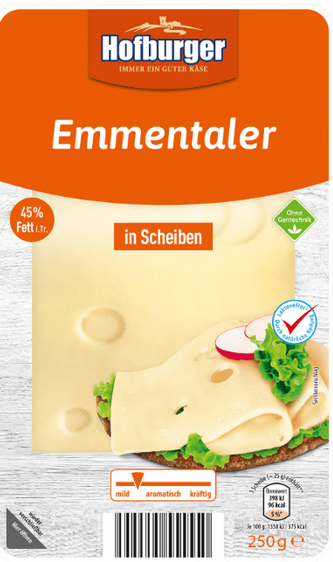Descriptive sign as collective mark? – Emmentaler
The case: Emmentaler has been produced and sold not only in Switzerland but also in various Member States of the European Union, such as Germany, for a long time. The cheese takes its name from ‘Emmental’, a hilly, Swiss region in the Bernese Mittelland, where it was invented in the 13th century. The German word Emmentaler means ‘from Emmental’. The name is used on its own and has nothing additional that might indicate its place of production, for example:

Emmentaler therefore was not included in the protective agreement on origin between the Swiss Confederation and the European Union, which came into force in 2011. Its inclusion failed due to resistance from the EU.
In 2017, ‘Emmentaler Switzerland’ tried to protect the word ‘Emmentaler’ as a collective trademark in the European Union, in relation to its Swiss association.
![]()
A collective trademark is a separate trademark category alongside the individual trademark and the certification trademark. Unlike an individual mark, it does not distinguish the origin of the goods and services as coming from a single company. Rather, it distinguishes the goods and services offered by the individual association members from the products of companies that do not belong to the association. This distinction can also be made on the basis of the characteristics of the goods specifically produced by the members of the association. Geographical indications can also be protected with a collective mark.
Like all other types of trademarks, however, the collective mark is not a carte blanche for the protection of descriptive indications. Thus, with the exception of geographical origin, no indication of the kind, quality, quantity, intended purpose, value, time of production or any other characteristic of the goods in question can be protected via the collective mark.
Is ‘Emmentaler’ now a distinctive indication of this particular cheese, produced by the members of the Emmentaler Switzerland Association? Does it constitute a geographic indication of origin that can be protected as a collective mark? Or is it simply the generic name for a special type of cheese and thus only a descriptive indication of the characteristics of the cheese – hence fundamentally ineligible for protection?
These questions arose in the proceedings before the EUIPO concerning collective mark protection.
Since a trademark is directed at consumers, the understanding of such a designation depends on those consumers. If the latter can immediately and without further reflection take from the indication a description of the goods in question, or a particular characteristic of the goods, the designation cannot be said to distinguish the products according to their origin and therefore is inherently ineligible for protection.
The decisive factor was therefore how the word Emmentaler comes across to the general consumer in the market.
Emmentaler is widely used in the European Union without any indication of a specific place of production. Nor does the designation thereby indicate an operational origin. If several economic operators in a Member State manufacture goods and market them under a particular sign without the sign indicating the commercial or geographical origin of those goods, this may suggest that the relevant public perceives the sign as designating a particular characteristic of the goods and thus the sign would be classed as descriptive. Consistent with this, the term Emmentaler is also described in the Duden dictionary as ‘Swiss cheese’, but at the same time merely as ‘Emmentaler cheese’, which shows that only one type of cheese is meant.
On this basis, the General Court of the European Union found that the general public in the European Union does understand the term Emmentaler only as a generic or descriptive term for a specific type of cheese.
Whether the use of the designation Emmentaler is also protected by special state agreements was irrelevant for the consideration of trademark law. The perception of the general public, which is the decisive factor, is primarily determined by how the sign is perceived in the market.
The protection of Emmentaler as a collective trademark was denied.
General Court of the European Union, 24 May 2023, T-2/21
Learnings: A collective mark must still fulfil the general requirements for protection under trademark law. In particular, it must not be considered to contain any indication of the kind, quality, quantity, intended purpose, value, time of manufacture or any other characteristic of the products potentially protected by it. The decisive factor is how the public perceives the designation of such a collective mark. The collective mark is not a carte blanche for descriptive indications.